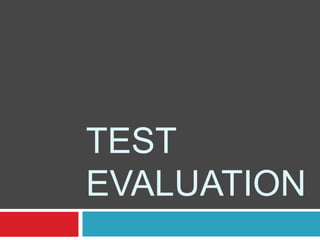Test evaluation
- 2. Book Content
- 3. Testing Reliability ïĻ Reliability is the degree to which an assessment tool produces stable and consistent results ïĻ Consistency of measures across different times test forms and context
- 4. Testing Validity ïĻ Appropriateness and usefulness of the test ïĻ Validity refers to the degree in which our test or other measuring device is truly measuring what we intended it to measure.
- 5. Face Validity ïĻ Face Validity ascertains that the measure appears to be assessing the intended construct under study. ïĻ Related to the test overall appearance
- 6. Content Validity ïĻ Content validity is qualitative in nature, and asks whether a specific element enhances or detracts from a test or research program. ïĻ Related to objectives and their sampling
- 7. Construct Validity ïĻ It implies using the construct correctly (concepts, ideas, notions)
- 8. Criterion Validity ïĻ Criterion-Related Validity is used to predict future or current performance - it correlates test results with another criterion of interest.
- 9. Concurrent Validity ïĻ Concurrent validity is the degree to which the scores on a test are related to the scores on another, already established, test administered at the same time, or to some other valid criterion available at the same time.
- 10. Predictive Validity ïĻ Capable of anticipating some later measure. ïĻ Estimates the relationship of test scores to an examineeâs future performance as a master or non master
- 11. Practicality Validity ïĻ It is easy to construct, administer, score and interpret












